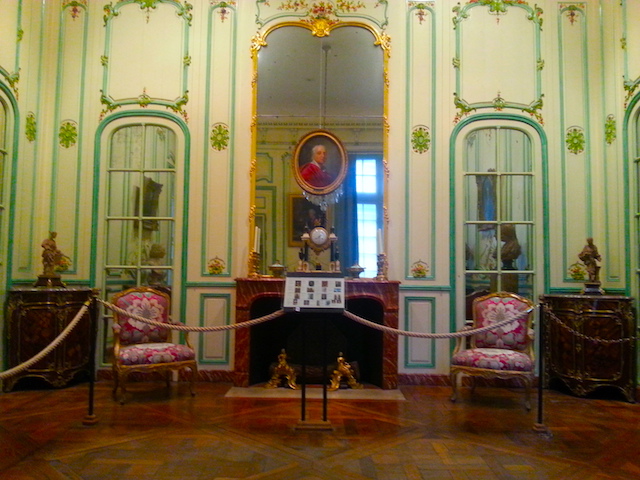
A Childhood at Versailles consists of the first 5 chapters of the memoirs of Mme de Boigne (1781-1866), née Adèle d’Osmond, who was a French salon hostess and writer. She was born in the Château de Versailles and lived at the court of Louis XVI and Marie-Antoinette until her family fled to England during the Revolution. Later in her long life, she married a rich soldier of fortune 30 years her senior, hosted a brilliant salon in Paris, and became an intimate of the last French queen, Marie-Amélie, consort of King Louis Philippe (r. 1830-1848). Childless herself, Mme de Boigne addressed her memoirs to her grandnephew. The memoirs were not published until 1907, under the title Récits d’une tante, or An Aunt’s Tales. They’ve never been published in English, as far as I know, so I’ve decided to translate the first 5 chapters, the ones that take place mainly at Versailles, and post them here on this blog for interested readers to enjoy for free.
The chapters are quite lengthy, so I’ve broken each one into several parts. In Part 2.3, the author recalls the Princesse de Guéméné, the rather eccentric governess of Louis XVI and Marie Antoinette’s children. At any rate, she was their governess until a sudden reversal of fortune…
A Childhood at Versailles, Chapter Two, Part 3 (Part 2.3)
At Versailles, the Princesse de Guéméné’s house was the one most frequented by my parents. My father had some family connection to her, and she overwhelmed them with kindness. She was a very singular person. She had a great deal of intellect, but she put it to use by plunging into the follies of spiritualism. She was always surrounded by a multitude of dogs to whom she rendered a kind of worship, and let on that through them she was in communication with intermediary spirits. In the middle of a conversation in which she showed wit and judgement, she would suddenly stop short and fall into a trance. She sometimes told her intimates what she had learned on these occasions and was offended to notice any signs of incredulity.
One day my mother found her in her bath, wreathed in tears.
“You are ill, princess!”
“No, child, I am sad and horribly tired; I spent the whole night fighting for this unfortunate child (motioning towards the Dauphin), but I could not beat them. They won and there will be nothing left for him, alas! And what a fate the others shall have!”
My mother, accustomed to the princess’s aberrations, paid little attention to these words; she remembered them afterwards and told them to me.
The Queen often came to Mme de Guéméné’s apartments, but less constantly than she went to Mme de Polignac’s. Mme de Guéméné was too much a great lady to reduce herself to the role of a favourite.
Her office obliged her to sleep in the Dauphin’s room. She had arranged an apartment for herself wherein her bed was placed against a mirror made of regular glass that looked into the little prince’s room. When what was called the remuer, which is to say the swaddling of the infant in the presence of the doctors, had taken place in the morning, thick curtains were drawn over this mirror, and Mme de Guéméné began her night. Until then, after having gone to bed very late, she had passed the time reading and writing. She had an immense quantity of precious stones that she never wore, but which she liked to lend unostentatiously. There was no great occasion at Court at which Mme de Guéméné’s parures were not to be seen.
In summer, she often dined in her little house in the Avenue de Paris, to which the Children of France were often brought. One day, when they had left escorted by bodyguards, someone saw fit to express astonishment at such an equipage for children in arms. Mme de Guéméné replied drily, “Nothing could be simpler when I am their governess.”
Madame, the King’s daughter, who was designated by the title Petite Madame, already had such a sad physiognomy that people in the inner circle called her Mousseline la Sérieuse.
Mme de Guéméné bore with admirable courage the reversal of fortune brought on by the sudden bankruptcy of the Prince de Guéméné. My parents went to see her in an old chateau that her father, the Prince de Soubise, had lent her. She lived there in mediocrity bordering on penury, but they found her, if it were possible, even more the great lady than she had been at Versailles. She was very touched by this visit. Crowds no longer surrounded her.
The Queen, in a hurry to give her position to Mme de Polignac, showed herself more severe than she would have been in other circumstances. Mme de Guéméné’s resignation was accepted joyfully and her exit hastened rather harshly. My mother, who bore the Princesse a filial attachment, was extremely afflicted by this turn of events, and never went to Mme de Polignac’s. Let us say right away, to the Queen’s honour, that far from holding it against my mother, she thought the more of her for it.
This concludes Part 2.3. The next part, which concerns the court-within-a-court of Louis XVI’s aunts, Mesdames Tantes, will appear next week.
Are you enjoying A Childhood at Versailles? If so, please share with anyone you know who might be interested!


















Leave a Comment